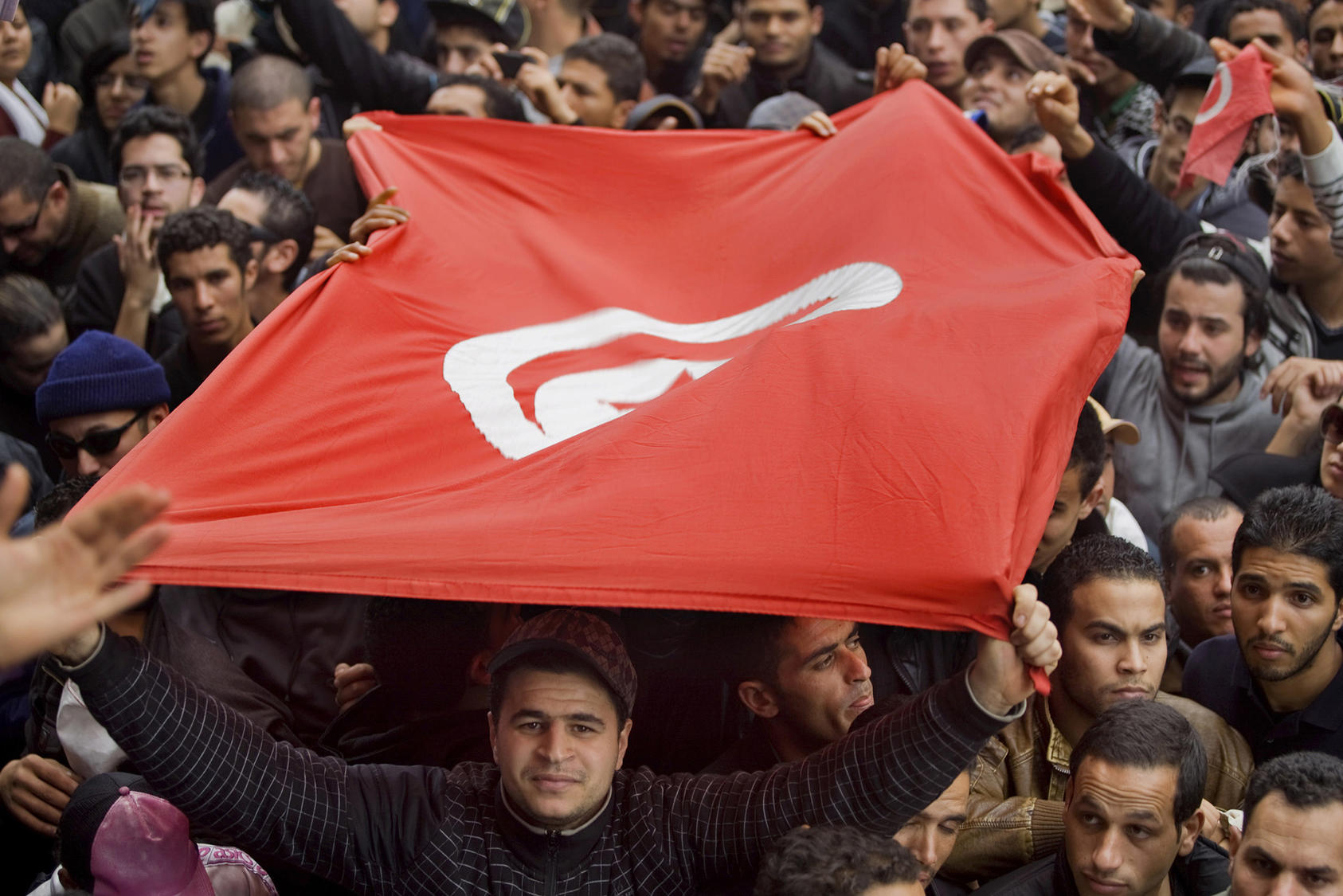Tunisia is the one country to have made a peaceful transition after the Arab uprisings began. The North African country spawned the uprisings on December 17, 2010 after a young street vendor—repeatedly harassed by police demanding bribes—set himself on fire to protest government corruption. His action inspired the first protests in remote Sidi Bouzid; unrest spread rapidly across the country. Bouazizi’s act of protest ignited waves of demonstrations across the Middle East, as people demanded jobs, better living conditions, and greater freedoms.
Police reportedly killed hundreds over the next month in Tunisia. President Zine al-Abidine Ben Ali’s pledges of reforms did little to quiet the discontent. On January 14, 2011, Ben Ali fled with his family to Saudi Arabia.
From January to October 2011, an interim government moved toward reform, recognized new political parties and disbanded Ben Ali’s party. Protests demanding further reform continued sporadically. On October 23, Ennahda, a moderate Islamist party, won the national elections and formed a coalition government with two secular parties.
But Tunisia’s fledgling democracy has faced repeated challenges from both Islamist and secular parties since the transition. In 2012, a tumultuous year, the new government attempted to control protests and violence throughout the country as thousands rallied for and against a more conservative religious government. An elected assembly worked on a new constitution that triggered feisty debates among secular and Islamist parties on the role of Islam in politics.
Tensions mounted in 2013 when two prominent secular politicians—Chokri Belaid and Mohamed Brahmi—were assassinated, spawning another political crisis and civil strife. Although authorities arrested Salafist militants, some protesters blamed Ennahda for the attacks. Thousands of Ennahda members countered with demonstrations in support of the government. Ennahda handed over power to an interim government in October 2013; it was tasked with organizing new elections. Ennahda's decision and the interim government were made possible as a result of the negotiations among the political parties facilitated by the "Tunisia National Dialogue Quartet" in September 2013.
In 2014, secular parties edged out Islamists at the polls. In the October parliamentary elections, Nidaa Tounes won 85 seats compared to 69 for Ennahda. Veteran politician Mohamed Beji Caid Essebsi, the head of Nidaa Tounes and a former prime minister, was elected president in December. But turnout was lowest among the young, who ignited the Arab uprisings; among cities, the turnout was lowest in Sidi Bouzid, the birthplace of the uprisings that spread across the Middle East and North Africa. Thousands of Tunisians, including many young men, left the country to join ISIS in Syria, Iraq or Libya; proportionately its militants made up one of the highest percentages of ISIS fighters from the region. Tunisian militants have fought in several foreign conflicts, including in Afghanistan (in the 1980s and after 2001), in Iraq (after 2003), and elsewhere, but in smaller numbers compared to the post-2011 period.
Despite political achievements, the economy still challenged Tunisians while the security situation deteriorated as a branch of ISIS emerged. In 2015, Islamist militants attacked the National Bardo Museum, killing 24 people; opened fired on a beach resort in Sousse, killing 39 foreigners; and assaulted a bus carrying the Presidential Guard. The government responded by declaring a state of emergency and engaged a security crackdown that restored a sense of public safety.
Political upheaval marred 2016. Nidaa Tounes, the ruling secular party in Parliament, splintered. Ennahda founder Rachid Ghannouchi declared the Islamist party was abandoning political Islam. In July, Parliament dismissed Prime Minister Habib Essid during a no-confidence vote. A month later, Nidaa Tounes member Youssef Chahed became the prime minister.
Tunisia’s troubled economy was the biggest challenge in 2017. The national unity government took some measures to stimulate growth, but it struggled to implement key reforms. High unemployment, a rising inflation rate, and tax increases plagued Tunisians. In January 2018, protests erupted in more than a dozen cities over price hikes. After killing a top leader of al-Qaida in the Islamic Maghreb, security officials said the movement might be trying to regroup in Tunisia.
For all the protests in 2017 and 2018, however, voter turnout in the first municipal elections, in May 2018, was at an all-time low since 2011. The low turnout reflected public fatigue after years of being disappointed by several governments and an array of parties. Ennahda beat its rivals but failed to win absolute majorities in many municipalities, including Tunis. In Tunis municipality, where turnout was 26 percent, Ennahda took 21 out of 60 seats.
Among the region’s 22 countries, Tunisia's progress is encouraging. It has a comparatively robust civil society. Institutions have undergone major reforms. And the international community has provided enthusiastic support for the little North African country. Yet even though Tunisia’s executive and legislative branches are now elected democratically, their practices are often reminiscent of the ancien régime. Public services are slow or inadequate. The economy is still troubled, although tourism revenues increased more than 40 percent in 2018 compared to the previous year. Extremism, especially spillover from the political chaos in neighboring Libya, remains a threat. The country lacks the necessary human and financial resources to deal with the return of militants. And transparency is limited. In early 2019, Tunisia’s transition still had a long way to go in either entrenching democracy or countering militant ideologies.
This timeline was assembled with the help of graphic research by Lindsay Jodoin and editorial research by Garrett Nada.
